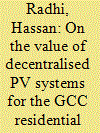| Srl | Item |
| 1 |
ID:
132790


|
|
|
|
|
| Publication |
2014.
|
| Summary/Abstract |
This paper explores people×s preferences for a Built in Photovoltaic (BIPV) renewable energy system to be integrated into housing construction. A novel methodology was developed, to study the case of Northern Cyprus, for better understanding of possibilities that abound in BIPV integration. The methodology incorporates Building Information Modeling (BIM) as a real-time design and economic assessment tool for BIPV choices. This serves to benefit both the construction companies and potential house owners in their decision-making. In addition, it uses a Contingent Valuation (CV) method to assess the Willingness to Pay (WTP) and the Willingness to Accept (WTA) compensation. The results indicate that the capital cost of PV is not instrumental in choice, and a lower feed-in tariff could be acceptable.
|
|
|
|
|
|
|
|
|
|
|
|
|
|
|
|
| 2 |
ID:
103335


|
|
|
|
|
| Publication |
2011.
|
| Summary/Abstract |
Based on the rich natural potential of the Gulf region, solar energy is expected to play a greater role in the future of the Gulf Corporation Council (GCC) countries. This study examines whether the integration of the photovoltaic (PV) into individual residential buildings in the GCC countries is worth the investment. A prototype residential building is developed and a building integrated photovoltaic (BiPV) system is then designed. The system performance is simulated, and through economic analysis, it is shown that the current BiPV technology is not a cost-effective option for the GCC countries based on the present electricity tariff, PV system cost and system efficiency. The only way such a system would be viable with current technology is if the electricity tariff were to increase substantially. However, if the tariff remains constant for the foreseeable future, BiPV solar energy technology will only be feasible if the total system cost drops drastically. This study shows that BiPV systems offer cost reductions in both energy and economic terms over centralised PV plants, especially if the costs of avoided building construction materials are taken into account. To bring about the benefits of BiPV technology for the GCC residential sector, therefore, the first logical and most practical step is the implementation of a continuous promotion strategy that consists of both subsidies for investments and reasonable tariffs.
|
|
|
|
|
|
|
|
|
|
|
|
|
|
|
|